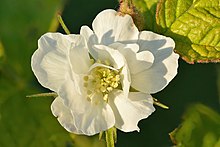Description:
– Plants have trailing stems with new roots along the length
– Stems covered with fine spines or stickers
– Flowers bloom in March and April, developing into green berries
– Berries turn from green to red to deep purple-blue when ripe
– Berries are sweet and less seedy than blackberries
Distribution and habitat:
– Common in the Northern Hemisphere
– Considered a beneficial weed
– Rubus caesius often found in coastal communities and sand dune systems
Ecology:
– Leaves eaten by larvae of some Lepidoptera species
– Peach blossom moths are known to consume the leaves
Uses:
– Leaves can be used to make herbal tea
– Berries are edible and sweet, used in raw form or in various dishes like cobbler, jam, or pie
– Historically, Cameron, North Carolina was known as the dewberry capital for large-scale cultivation and shipping
See also:
– Black raspberry
– Boysenberry, a cross between dewberry and loganberry
– Cloudberry, a dioecious Rubus species
– Youngberry
References:
– Plants Profile for Rubus aboriginum (garden dewberry) on plants.usda.gov
External links:
– Wikimedia Commons for media related to Category:Rubus
– Dewberry entry in the Encyclopædia Britannica, 11th edition, Vol. 8, 1911
The dewberries are a group of species in the genus Rubus, section Rubus, closely related to the blackberries. They are small trailing (rather than upright or high-arching) brambles with aggregate fruits, reminiscent of the raspberry, but are usually purple to black instead of red.




